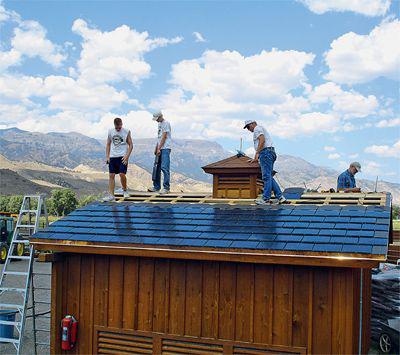Authors: Betsy Matheson
Tags: #Non-Fiction
DIY Projects for the Self-Sufficient Homeowner: 25 Ways to Build a Self-Reliant Lifestyle (36 page)

Now, about those rebates and credits: In many areas, homeowners going solar can receive sizable rebates through state, local, or utility-sponsored programs, in addition to federal tax credits, as applicable. All told, these financial incentives can add up to 50% or more of the total setup cost of a new PV system. To find out about what incentives are available through any of these sources, check out the Database of State Incentives for Renewables & Efficiency, online at
www.dsireusa.org
. Established solar businesses in any given area are also very well informed about incentives available to local residents.
Here are some of the factors that tend to affect the cost of a PV system, its effectiveness or efficiency, and the homeowner’s return on investment:
The house and geographic location—how much sun reaches the house; the roof’s slope and roofing material
Electric utility rates and net-metering rates
Increased home value—PV systems and other energy-saving upgrades can increase a home’s resale value (often without raising the property value used for tax assessment)
Loan rate, if the system is financed

This fiber-cement
shingle roof features an integrated array of shingles laminated with thin-film PV modules.
With so many factors to consider, getting to the bottom line can be complicated. Full-service solar companies will perform a cost/benefit analysis to help potential customers make a decision based on the financial picture. Of course, you should always check their numbers and scrutinize any variables used. You can also learn a lot by talking to other homeowners in your area who have had similar systems installed. Are they getting the return they expected? Have their systems been reliable and low-maintenance? Would they change anything given the chance to do it over?
Working with Solar Professionals
Companies that provide solar equipment and system design, installation, and maintenance services are rising in number every year. A few of these were around during the lean years of the 1980s and ‘90s, but many more have sprouted up in the last decade or so. In any case, this is now a highly competitive industry, so you can, and should, expect great service at competitive prices.
The reputation and reliability of your local solar provider are important considerations, but perhaps more important is the stability of the original equipment manufacturers (OEMs) who produce the main parts of your system and who carry those long warranties. Many of these are large, well-established companies with expertise in energy and/or electronics, so it’s a good bet they’ll be around in 20 or 25 years to honor their product warranties. Always discuss warranties carefully with your solar provider.
At present, the solar industry really isn’t set up for do-it-yourself system design and installation. Professional installation may run you around 15% of the total system cost—quite a low rate for the home improvement industry—and that amount is subject to rebates and credits, which are based on installed system prices.
Before giving you a quote for the system package, a solar provider will want to know about your home, what type of roofing you have, and what the southern exposure is like. To ballpark the size of system you’ll need, they’ll probably look at your utility bills from the past year and ask how much power you want to get from solar: Will it cover all household demand or just a portion of it? You may have to pay a fee to cover the provider’s legwork required for working up an accurate quote.
Services likely to be included in a provider’s system package are:
Complete system design and installation
Guarantees on workmanship/installation
Obtaining building/electrical permits
Coordinating hookup with utility company
Obtaining rebates and credits
Help with OEM warranty claims
